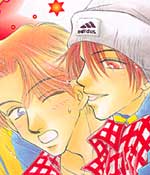
by Luis Reyes
While at a convention last February, I wandered into a panel attended primarily by women - which introduced me to a kind of fiction that I, as a straight male who may very well admire it, could never really fully appreciate. Yaoi is male on male fiction created by women for consumption by women. Yaoi is ubiquitous, but remains an underground phenomenon; most, but certainly not all, of its fans cower in the folds of social taboo. Yaoi's appeal is varied, its themes oftentimes misunderstood, and its definition cloudy. But there's no mistaking that it's growing in public awareness. Japan's semi-annual Comic Market was initially dominated by doujinshi (fan comics) in the shounen (for boys) genre. With the growth of the women's role in the Japanese work force, doujinshi content has shifted toward shoujo (for girls) titles, and with that, the extremes of the genre have come to enter the field en masse. Yaoi has staked a substantial claim in the halls of Comike, and Comike itself has helped to drive up a flagging Japanese economy - as women become more liberated and financially solvent, their dollars pour into this culturally marginalized genre of comic book art. Stateside, YaoiCon launches on September 1st in one of the US's hotbeds of liberal thinking and alternative sexuality, San Francisco. Yaoi is now so pervasive that fan fiction sites on the web that disapprove of it have to declaim their non-yaoi policy, otherwise they will most likely be inundated with prurient tales of male on male erotica. And as the genre swells with fans, it also swells with potential writers. Very few yaoi writers are professional, or, if they are professional, they don't make their living writing yaoi stories. Fans write for each other. But why is this form of erotica, and in some cases raw pornography, growing? The popularity of yaoi in the US stems from both a relatively recent devouring of Japanese manga and anime by the female demographic, and a deeper rooted fascination with slash literature (erotica based on characters in popular science fiction shows, such as Captain Kirk and Mr. Spock). "Women have been writing Star Trek pornography since at least 1976 ... as fans recognized, through seeing the episodes countless times in syndication and on their own taped copies, that there was an erotic homosexual subtext there, or one that could easily be made to be there," writes Constance Penley in her essay "Brownian Motion: Women, Tactics, and Technology" [published as part of a collection of essays edited by Penley and Andrew Ross called "Technoculture"]. Penley goes on to explain how the use of slash empowers women in arenas traditionally dominated by men and therefore is a feminist tool. But trying to pin yaoi to its function can be an exercise in futility, so I opted to explore yaoi by speaking to its fans. |

